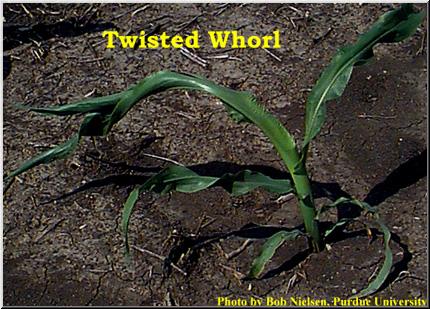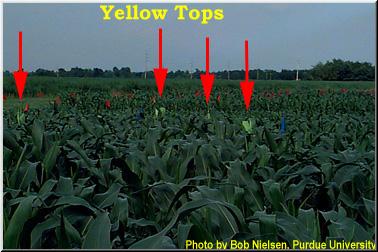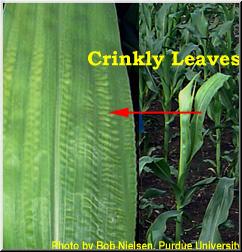Rapid Growth Causes Twisted Whorls in CornR.L. (Bob) NielsenAgronomy Department , Purdue University West Lafayette, IN 47907-1150 Internet address: rnielsen@purdue.edu
I will admit that this article is late in coming, since folks have been reporting this curious corny phenomenon for the past several weeks, but I offer my comments nonetheless. The phenomenon of which I speak are those fields exhibiting symptoms of unusual twisted growth in scattered plants. The whorls of affected plants are tightly twisted, often bent over severely, and do not unfurl on a timely basis. One’s natural instincts would blame the twisted growth on herbicide injury. But, in most cases, the cause is something entirely different. |
 |
| The problem appears to be related to a combination of initial slow corn growth (typically cool growing conditions) followed by a rapid transition to excellent corn growth (typically warm weather plus ample moisture). In 1999, much of May was characterized as a slow corn growth month while much of June has seen corn growing by leaps and bounds. Certain hybrids react to such a change in growing conditions by basically going 'bonkers'. The upper whorls of the plants don't unfurl properly. Younger leaves deeper in the whorl continue to grow rapidly, but are unable to emerge from the unfurled upper leaves. The now tightly twisted whorl then bends and kinks from the pressure exerted from the younger leaves' continued growth. The growth stage where this phenomenon seems to occur is around five to six visible leaf collars (about knee-high). At the peak of the problem, the appearance of these plants is indeed unsettling and one would think that the whorls would never unroll properly. Given another week, though, the majority of the affected plants do unroll and continue to grow normally. Yield effects from the period of twisted growth will be minimal, if any. If you didn't notice the twisted growth to begin with, you may notice the appearance of 'yellow tops' across the field after the whorls unroll. The younger leaves that had been trapped inside the twisted upper leaves emerge fairly yellow due to the fact that they had been shaded for quite some time. In addition to being fairly yellow, the leaves will exhibit a crinkly surface caused by their restricted expansion inside the twisted whorl. Another day or two will green these up and the problem will no longer be visible. |
  |